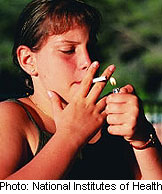
TUESDAY, Dec. 7 (HealthDay News) — Teens who are allowed to watch R-rated movies are more likely to take up smoking than teens whose parents bar them from viewing mature movie content, according to new research.
In fact, the study authors estimated that if 10- to 14-year-olds were completely restricted from viewing R-rated movies, their risk of starting to smoke could drop two to threefold.
However, the study found that only one in three young American teens is restricted from viewing R-rated films, which are restricted at the box office to teens 17 and older unless the child is accompanied by an adult.
“When watching popular movies, youth are exposed to many risk behaviors, including smoking, which is rarely displayed with negative health consequences and most often portrayed in a positive manner or glamorized to some extent. Previous studies have shown that adolescents who view movie smoking are more likely to begin smoking,” said the study’s lead author, Rebecca de Leeuw, a doctoral student at Radboud University Nijmegen in the Netherlands.
“Our findings indicate that parental R-rated movie restrictions were directly related to a lower risk of smoking initiation, but also indirectly through changes in children’s sensation seeking,” de Leeuw added.
“Sensation seeking is related to a higher risk for smoking onset. However, children with parents who restrict them from watching R-rated movies were less likely to develop higher levels of sensation seeking and, subsequently, at a lower risk for smoking onset,” she explained.
Findings from the study are scheduled to appear in the January issue of Pediatrics.
The study included data from a random sample of 6,522 American children between the ages of 10 and 14 years old. The average age of the children at the start of the study was 12.
The children were followed for two years, and given periodic re-evaluations at 8, 16 and 24 months to see if they had begun smoking during that time period.
Just 32 percent of children reported that their parents fully restricted them from seeing R-rated movies at the start of the study.
The researchers found that the percentage of children who were willing to try smoking went up with their parents’ level of permissiveness regarding R-rated movies. Only about 8 percent of children who had never seen an R-rated movie had tried smoking during the study period, while nearly 30 percent of those who could see R-rated movies “all the time” had tried smoking.
The researchers felt that the parents’ permissive attitudes, coupled with exposure to sensation-seeking behaviors in movies, probably influenced the increased risk of smoking in teens.
“This study really adds to the whole body of work that has shown that regular exposure to smoking in movies makes it more likely that a teen will take up smoking,” said Dr. Deborah Moss, an assistant professor of pediatrics at Children’s Hospital of Pittsburgh.
“Parents should not be afraid to say no. Restricting exposure to R-rated movies reduces smoking, and smoking is a gateway behavior. [Restricting R-rated movies] is one more thing that parents can do to raise a healthy teen,” Moss added.
“Many parents relax their restrictions regarding R-rated movies during adolescence, but our results suggest that continued restriction is an effective means of reducing adolescents’ risk for smoking onset,” noted de Leeuw.
In addition, de Leeuw said, the study authors think that movie theaters and video stores should help parents by enforcing policies restricting anyone under 17 from viewing or renting R-rated movies without a parent present.
“This may prevent children from watching R-rated movies without their parents’ knowledge,” she added.
More information
Learn more about preventing children from smoking from the American Lung Association.

